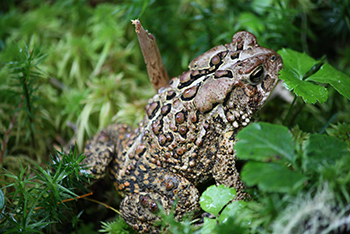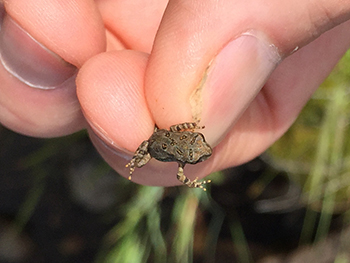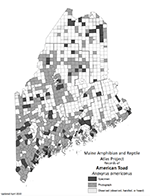Home → Fish & Wildlife → Wildlife → Species Information → Reptiles & Amphibians → American Toad
American Toad
Anaxyrus americanus
On this page:

Photo: Trevor Persons
Distinguishing Characteristics

Photo: Trevor Persons
- Plump, medium-sized, approximately 2 to 4 inches in length
- Distinct rough, spotted, warty skin. Warts may be soft or spiny
- Color reddish brown, brown, gray, greenish gray, or even black
- Breeding call is a prolonged (>20 second) high-pitched trill
Status and Distribution in Maine
- Common and secure
- Statewide
Habitat
- Forested areas, open fields, urban or suburban yards, wetlands, lakes, rivers and streams, and even high-elevation mountains
- May burrow into soil during hot weather
- Breeds in open, shallow water in ponds, lakes, and ditches
Diet
- Eats a wide variety of invertebrates including insects, snails, and spiders
Seasonal Changes
- Burrows into soft soil to hibernate during winter
Natural History Notes
- Explosive breeder, most populations complete breeding within 15 days of its start
- Breeds mid-April through mid-May
- Toxic skin secretions discourage predation upon toads. Can be safely handled, but should then avoid touching the face (eyes, nose, mouth) before washing hands
Share Your Sighting
There is much still to learn about the distribution and ecology of Maine’s herpetofauna, and we encourage members of the public to share their photo-documented observations as part of the Maine Amphibian & Reptile Atlas Project (MARAP).
To see if a township still needs documentation of a species, consult this distribution map (PDF). If a township lacks a photo or specimen record, we want your observation!
There are two ways to share your observations:
Submit your reptile or amphibian observation online
No service? No problem. Click here to download the survey to your device while connected, then take offline to collect observations from anywhere. Tip: The survey works best on Google Chrome and Safari.
Or upload sightings to the iNaturalist citizen science project through their website at iNaturalist.org or mobile app.
- When submitting an observation through iNaturalist add a description of the location (and other noteworthy information) to the “notes” field. This serves as a check on the locations automatically generated by smartphone cameras, which may be imprecise if cell service or GPS coverage is weak.
Thank you for doing your part to help conserve Maine’s reptiles and amphibians.
